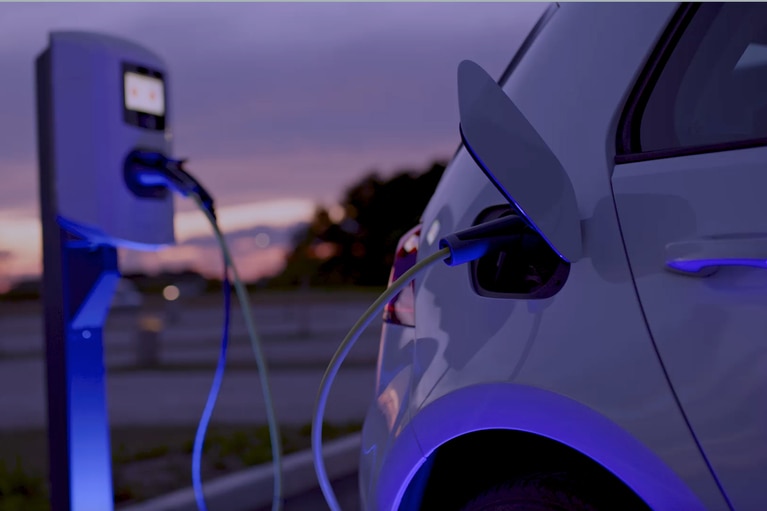Automotive Event
Vicor unveiled four new approaches to solve automotive electrification challenges

Learn how the versatility of power modules help solve automotive electrification challenges
Vicor delivered four presentations at World Congress 2023 that solve the toughest automotive electrification problems. The presentations highlight the flexibility of the Vicor power modules and how they can be used throughout the vehicle to address efficient power conversion demands while reducing packaging and weight. Vicor solutions deliver high performance, using the highest density power modules and leveraging unique architectures that can deliver up to a 50% reduction in power losses.
Vicor presented at four WCX sessions
Reducing range anxiety by reducing harness weight using power modules
Presented by Nicolas Richard, Director Automotive Sales and Field Applications, Vicor EMEA
12V wire harnesses represent significant weight and cost in modern complex vehicles. Reducing weight frees space and increases range, which is so important today. Stepping up voltage is a more efficient approach to transferring power around the vehicle through thinner wire harnesses, which weigh less. This new innovative approach can easily be implemented with SAC ratio metric modules to step up and step down the voltage efficiently using power modules while appreciably reducing harness weight.

Nicolas Richard is Director of Automotive Sales and Field Application Engineering in Vicor, Europe. Nicolas has 19 years of automotive experience in Infotainment, ADAS, Power electronics systems (DC-DC, Inverter, BMS) and semiconductors . He held positions in Engineering, Program management, Field Application Engineering and Sales at Tiers 1 and Tier 2 automotive companies, including Siemens VDO, Continental, Fairchild, ON Semi, IDT and Renesas. Nicolas earned his MSc in Electrical Engineering from ESIEE in France.

Managing high-voltage line ripple rejection using high-bandwidth DC‑DC converters
Presented by Haris Muhedinovic, Automotive Principal Field Applications Engineer, Vicor
Ranya Badawi, Power Converter Engineer, General Motors
Steven Wybo, Technical Specialist, Power Electronics, General Motors
Inverter switching can cause high voltage/current ripple of significant magnitude on the HV bus with frequency up to 20kHz. This ripple puts demanding requirement on main DC-DC converter that supplies the 12V bus. Special concern is on design of EMI filter, whose main task is to attenuate noise caused by converter. In order to keep converter stable, system reliable and 12V bus quite, EMI filter design can lead to oversized components, too much heat dissipation and even struggle with EMC compliance. Using power modules, leveraging the Vicor Sine Amplitude Converter (SAC™), design of the filter is simplified and 12V bus is kept quiet and reliable, thanks to high bandwidth controller that manages the voltage ripple caused by inverter switching.

Haris Muhedinovic works with OEMs and TIERs to design and develop highest performance power solutions for most demanding automotive applications. With his interest in power electronics and electronics systems, Haris is aware of new technologies and trends in industry, which allows him to implement power solutions to meet the most demanding specifications. Haris received his MSc from the University of Sarajevo and has 7 years of experience in power electronics in design and application engineering.


Ranya Badawi is a power converter engineer at General Motors where she develops HV power converters for both on-board and off-board vehicle applications. Her interests are in power electronics, converter control and system level integration and stability. Ranya received her MEng from the University of Cincinnati and is currently pursuing her PhD in Electrical and Computer Engineering at Oakland University. She has 6+ years experience in the design and development of high voltage power converters.


Steven Wybo is a Technical Specialist in DC-DC Conversion at General Motors. He has 30 years of experience in power electronics, mostly focused on automotive electrification. While at General Motors, Steven has developed and launched automotive DC‑DC for several GM electric vehicles and hybrid vehicles. Prior to joining General Motors, Steven designed automotive power electronics for Ford/Visteon. Steven earned a BSEE degree from the University of Michigan. He has completed graduate work in power electronics at the University of Colorado-Boulder.

Adapting 400V and 800V architectures – bidirectional conversion
Presented by Matt Jenks, North American Automotive Director, Vicor
As OEMs transition from 400V to 800V HV batteries, re-use of legacy 400V subsystems and interoperability of systems will require a solution to power 400V loads and provide bi-directional capability between 400V and 800V systems.
Bi-directional power modules solutions are perfect for adapting existing proven 400V applications and infrastructure to 800V electric vehicle architectures. High density power modules are extremely efficient, light-weight and easily scalable. The bi-directionality also offers flexibility to power a wider variety of applications.

Matthew Jenks is Director of Automotive Sales and Field Applications Engineering in Vicor, North America. Matthew has 25+ years of automotive electronics experience in modules, power electronics, custom ICs and semiconductors. He has held positions in Sales, Marketing, Engineering and Field Applications at Tier 1 and Tier 2 automotive companies, including Infineon, STMicroelectronics, International Rectifier, Visteon and Motorola. Matthew earned his BS in Electrical Engineering from Michigan State University.

Building redundancy in electrical systems that power 400 or 800V electric vehicles
Presented by Patrick Kowalyk, Automotive Principal Field Applications Engineer, Vicor
Vicor Corporation converters provide a redundant system by providing an isolated ratio metric frontend that is easily paralleled and a regulator with the built-in paralleling feature.
The traditional DC-DC Converter operating from the 800V battery, creating a 12V isolated, regulated output that is typically a single power train. If any of the power elements in the power train fails, one could lose the 12V, a chemical redundancy (battery) is required so not to disable the vehicle. The 800V battery can be split into two 400V batteries connected in series to support better redundancy.

Patrick has been solving power delivery issues for over 20 years with Vicor’s innovative, high power, high density and high-efficiency solutions. Patrick is instrumental in helping power engineers architect new Automotive power delivery systems. He has a BS in Electrical Engineering from the Illinois Institute of Technology.

Related content

Solving 400V/800V EV fast-charging compatibility

Article: In the age of electrification, is the 12V battery still necessary?

eBook: Accelerate vehicle electrification with the smallest, lightest power modules

Video: Collaborate with Vicor to accelerate vehicle electrification
Related products

The smallest, lightest power modules
About WCX™
As North America’s largest technical mobility event, WCX brings together the brightest minds in mobility for critical conversations. The WCX™ World Congress Experience is where the engineering community convenes on mobility’s biggest hurdles from mass deployment of electric vehicles to developmental timelines for autonomous vehicles to understating of global supply chain constraints impacting the automotive industry. World Congress Experience is an event of the Society of Automotive Engineers (SAE).